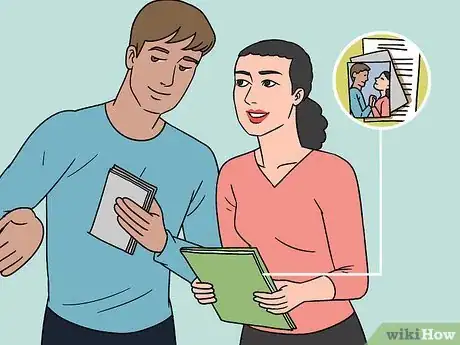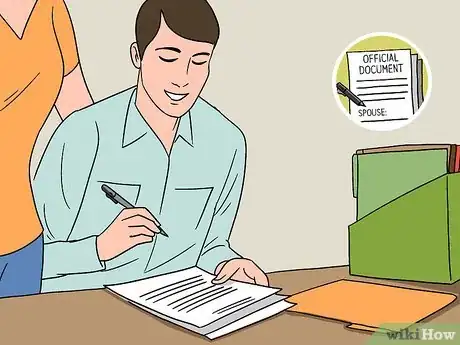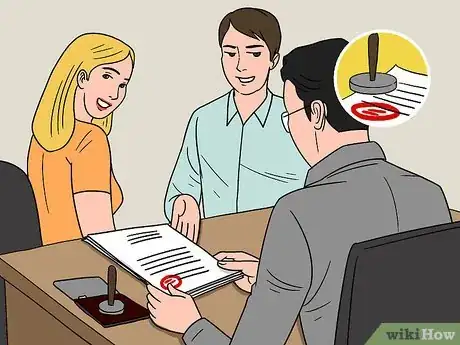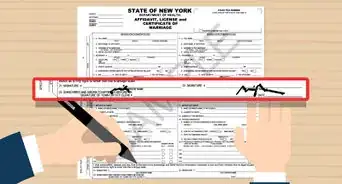This article was written by Jennifer Mueller, JD. Jennifer Mueller is an in-house legal expert at wikiHow. Jennifer reviews, fact-checks, and evaluates wikiHow's legal content to ensure thoroughness and accuracy. She received her JD from Indiana University Maurer School of Law in 2006.
This article has been viewed 7,088 times.
Married couples have legal rights in the US that unmarried couples don't, including the right to make life decisions should one of them become incapacitated. Some states recognize common law marriage, which means that you and your partner are married even if you didn't get a state license or have an official ceremony. However, common law marriage doesn't automatically come into being. You must prove to a judge that a common-law marriage should be recognized because the two of you agreed to be married, lived together as spouses, and held yourselves out in public as a married couple. All three of these things must be proven before a judge will recognize your common law marriage.[1]
Steps
Agreeing to Be Married
-
1Demonstrate that a marriage between you and your partner would be legal. You can't have a common-law marriage if the two of you wouldn't be eligible to get officially married in the state where you live. Generally, this means that at the time the marriage began:[2]
- Neither of you was already married to anyone else
- Both of you were over the age of 18
- You would have been allowed to get married in the state where you live
- Both of you agreed to be married, or live as a married couple
Tip: If you have a same-sex partner, you can only claim a common-law marriage from the date that same-sex marriage was legalized in the state where you live, even if you've been living together as a married couple for longer.
-
2Sign a Declaration of Informal Marriage at the county clerk's office. In some states, you can sign a declaration form that attests that you have a common-law marriage without needing to go to a court and have a hearing before a judge. The form will then be considered valid proof of your marriage within the state.[3]
- Declaration of marriage forms may not be recognized in other states if you move, especially if you move to a state that doesn't recognize common-law marriage.
Advertisement -
3Petition the court to recognize your relationship as a marriage. In some states, you and your partner can appear before a judge and ask them to recognize your common-law marriage as a legal marriage. If the judge approves, your marriage will be legal as of the date you originally started living together as a couple.[4]
- This option is typically available in states that don't recognize common-law marriage. If the state recognizes common law marriage, you don't need any certification from a judge. As common-law spouses, you enjoy the same rights and privileges that legally married couples do.
Tip: If you have to petition the court to recognize your relationship as a marriage, talk with your partner about whether it might be easier just to get legally married. It would likely be cheaper, and would have the same effect unless there is a reason you need to "backdate" the marriage to the date you originally got together.
-
4Provide evidence of a wedding ceremony or exchange of vows. A wedding ceremony or exchange of vows is only considered legal if the officiant filled out the appropriate information on a marriage license issued by the state where you and your partner live. However, if you had an informal ceremony or exchange of vows, you can use that occurrence to prove that the two of you agreed to be married.[5]
- To prove that the ceremony or exchange of vows happened, you could show photos of the event or get statements from the officiant or from friends and family who attended.
Living with Your Partner
-
1Share a primary home together. To prove that you and your partner are common-law married, you need to live in the same home for a certain number of years, typically at least 5 to 7 years. Generally, this would mean that you would move all or most of your belongings into the same residence.[6]
- It also helps if prove that you share a primary home if both of you are listed on the mortgage for the home. If neither of you owns the home, it may help if you are both listed on the lease, but this generally isn't as compelling as joint ownership because most landlords require all adults to be listed on the lease.
- If you happen to own more than one home, you can still prove that you have a common-law marriage if you live in the same place most of the time. For example, if you moved in with your partner and rented out the home that you owned, this would prove that you were living with your partner and that your shared home was your primary residence.
-
2Spend most of your time in the home together. In addition to sharing a primary home, you also must show that both of you spend the vast majority of your time there together. Even if you jointly own the home, you likely won't be able to prove that you have a common-law marriage if one of you spends most of their time somewhere else.[7]
- For example, if your partner owns a business in a city 100 miles away and spends weekends in that city, then returns to the home on weekends, the time you spend together would not be considered continuous for the purpose of proving that you have a common-law marriage.
- This doesn't mean that neither of you can ever go on trips separately, however. For example, if one of you travels each year to a convention for work, that wouldn't destroy the continuity.
-
3Provide evidence that you have a sexual relationship. This may seem nosy to you, but generally, judges need to know that you and your partner are living together as a couple, not as roommates or friends. Typically, this means the two of you have a sexual or romantic relationship.[8]
- Sharing a bedroom can serve as evidence that you are living together as a couple. However, you can have separate bedrooms and still prove that you are living together as a couple. For example, separate bedrooms would be acceptable if one of you had a medical condition or disability that made it difficult to sleep with another person.
- If you or your partner are asexual or aromantic, you can use other information to establish that you lived together as a couple. Generally, show things that you do for one another or with one another that you wouldn't do with a friend or family member.
Tip: If you and your partner have children together, this can be strong evidence that you have a common-law marriage, even if those children are adopted.
Holding Yourselves out as Married
-
1Use the same last name as your partner. If you legally changed your name, that would provide strong evidence that you were holding yourself out to other people as married. However, you don't necessarily have to legally change your name to simply use the same last name in many contexts.[9]
- For example, you could introduce yourself to people using the same last name, or use that last name on social media accounts.
- Generally, you would have to use your legal last name on identification and financial and legal documents. However, you could still tell people to call you by the other name. For example, you could "go by" the same last name at work, even though your legal last name was different.
-
2Exchange and wear wedding rings. A wedding ring is a common symbol that tells anybody who sees you that you are married. If both you and your partner wear wedding rings, this can help prove that you were holding yourselves out as married.[10]
- Wedding rings generally should be accompanied by an acknowledgment that you're married. For example, whenever anyone saw the ring and asked if you were married, you would routinely tell them that you were.
- For wedding rings to be proof that you're holding yourselves out as married, both of you need to wear them regularly. If one of you has to remove the ring for work, however, this would generally be understood and allowed.
-
3File joint tax returns as a married couple. The IRS doesn't require you to produce a marriage certificate when you change your tax filing status to "married filing jointly." Filing joint tax returns not only shows that you're holding yourselves out as married, but it also shows that the two of you intend to act as a married couple.[11]
- Typically, you'll need several years of joint tax returns for this to be solid evidence of a common-law marriage. Some states may require that you filed joint tax returns for the entirety of the time that you're claiming a common-law marriage.
-
4List each other as spouse on insurance policies and other official forms. Your insurance company or bank is typically not going to ask to see your marriage certificate to prove that you are married. If you list your partner's name as your spouse on any of these documents, this can be used to prove that you were holding yourselves out as married.[12]
- Listing your partner as a beneficiary on a life insurance policy could also carry the same weight.
- Joint accounts and joint debts can also be used as proof of your common-law marriage, even if you weren't specifically required to state that the other person listed was your spouse.
Tip: Listing your partner as a beneficiary on a life insurance policy can also prove a common-law marriage because it demonstrates that you intend for your partner to inherit your assets when you die. The evidence is stronger if both of you have listed each other on separate life insurance policies.
-
5Introduce each other as spouse. Friends, acquaintances, and family members often provide the strongest evidence that you are holding yourselves out as married. Testimony from enough people can create the understanding that within your community, it was commonly believed that you were married.[13]
- Friends and associates might also testify that when they referred to your partner as your "husband" or "wife," you didn't correct them.
- You can also show that when you meet new people at a social occasion or other event, you routinely introduce your partner as your spouse.
Tip: Listing the person as your spouse on your social media profile or referring to them in social media posts as your spouse also provides evidence that the two of you were holding yourselves out as married.
-
6Submit statements from relatives or friends. If you're appearing before a judge in court, you typically would call relatives or friends as witnesses to state that the two of you held yourself out as a married couple. However, if relatives and friends aren't able to appear as witnesses, you can have them submit signed, sworn statements describing the character of your relationship.[14]
- In some situations, such as if you're applying for government benefits, you'll need to send written statements to justify your claim. The government agency will let you know if such statements are needed.
- Normally, these statements should be signed in the presence of a notary. The notary will verify the identification of the person signing the statement and confirm that they are signing the statement of their own free will.
Warnings
- This article discusses how to prove a common-law marriage in the US. If you live in another country, the rules and procedures may be different. Talk to a local attorney who specializes in family law.⧼thumbs_response⧽
References
- ↑ https://www.iowalegalaid.org/resource/misconceptions-about-common-law-marriage
- ↑ https://texaslawhelp.org/article/common-law-marriage
- ↑ https://texaslawhelp.org/article/common-law-marriage
- ↑ https://www.utcourts.gov/howto/marriage/commonlaw/
- ↑ https://www.montanalawhelp.org/resource/common-law-marriage
- ↑ https://www.montanalawhelp.org/resource/common-law-marriage
- ↑ https://www.iowalegalaid.org/resource/misconceptions-about-common-law-marriage
- ↑ https://www.iowalegalaid.org/resource/misconceptions-about-common-law-marriage
- ↑ https://www.montanalawhelp.org/resource/common-law-marriage
- ↑ https://www.montanalawhelp.org/resource/common-law-marriage
- ↑ https://www.iowalegalaid.org/resource/misconceptions-about-common-law-marriage
- ↑ https://texaslawhelp.org/article/common-law-marriage
- ↑ https://www.montanalawhelp.org/resource/common-law-marriage
- ↑ https://www.ssa.gov/OP_Home/handbook/handbook.17/handbook-1717.html




































































